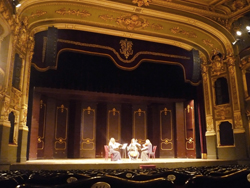
Daniel Fernandez of the Adamson Latin America technical support group was brought aboard to lend his expertise to the design process.
Specifically, he proposed the use of Metrix-I (installation version) line array modules for several reasons, including their purpose-built installation rigging system that also helps save on costs, in addition to providing additional flexibility by offering two different vertical coverage patterns.
“The flexibility of different vertical coverage patterns allowed us to obtain the ideal coverage pattern with a minimal number of boxes, thus adapting the design to the limitations of the architectural aspects of the venue,” Fernandez explains.
Each 2-way Metrix cabinet incorporates an Adamson-designed 8.5-inch Kevlar neodymium mid-low frequency cone driver optimized for the enclosure, as well as a 1.4-inch high-frequency compression driver on a proprietary wave-shaping chamber. Horizontal coverage pattern is 120 degrees.
The aforementioned vertical pattern is available in either 5 degrees (Metrix) or 15 degrees (Metrix W – Wide Angle Vertical Enclosure) in a total cabinet footprint measuring 8.5 inches high, 21.2 inches wide and 16 inches deep, and weighing just over 40 pounds.
Modeling Insight
The design took shape with left and right arrays comprised of 10 Metrix modules, with the tighter vertical dispersion models at the top providing extended coverage to more remote areas, transitioning to the wider vertical dispersion models to cover the main seating areas.
To further fine-tune and optimize the design, Fernandez utilized Adamson Shooter array modeling and configuration software, which provides 2-dimensional vertical and horizontal calculations and 3-dimensional SPL calculations, in addition to a mechanical view of the array structures.
“We needed to be very careful and accurate with the splaying of the arrays, and this is where help from Shooter was invaluable.”
“The software provided vertical and horizontal predictions in several frequencies and at different locations,” Fernandez says, who was supported on the project by Adamson’s Benoit Cabot.
“On top of that,” he continues, “we had to carefully account for some limitations with the array placement, since we were not allowed to open holes in the main structure of the proscenium in flying the arrays.”
The system team created and fabricated a special “arm” in order to fly the arrays from an upper support bean so that they did not touch the proscenium and surround structures.

